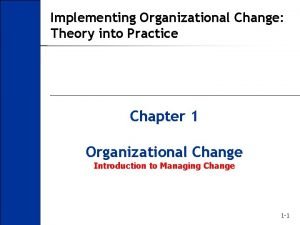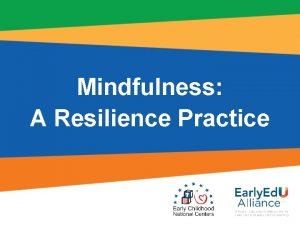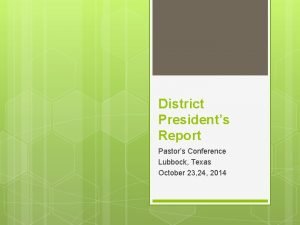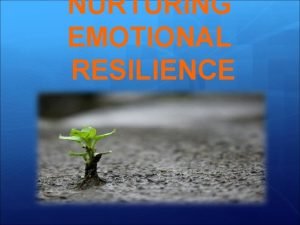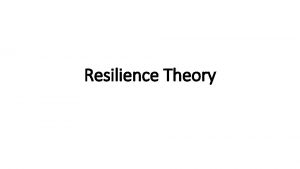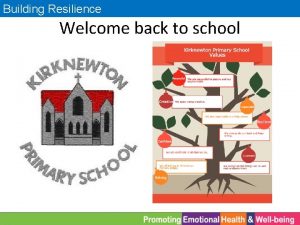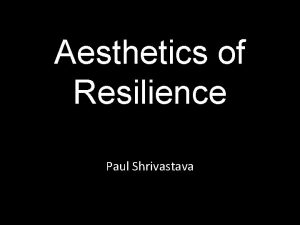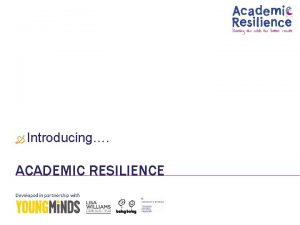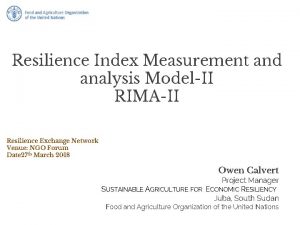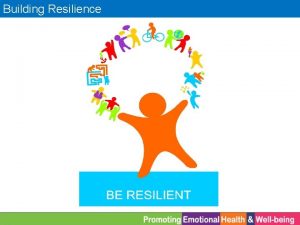Implementing RESILIENCE as a Practice June 2020 WELS



















- Slides: 19

Implementing RESILIENCE as a Practice June 2020 WELS Commission on Luther Schools Mentor Program Karen Fischer, LPC

The Lay of the Land - THEN

The Lay of the Land - NOW




Solve Survive Accept Adapt (Stay Miserable)

T ruly accept the loss has occurred E xperience the pain of the loss A djust to the new environment R einvest in the new reality

ü Explore the reasons for RESILIENCE ü Understand characteristics of RESILIENCE ü Identify RESILIENCE in self and others ü Incorporate RESILIENCE practice for yourself

§ Paul had some difficulties: Thorn in the flesh, Shipwrecked, Imprisoned, Beaten, Stoned, Endangered. 2 Corinthians 11: 22 -31 and 12: 7 -10

§ Ultimately, because Jesus called him, he bounced back. Not from his self reliance but because of his resilience in Christ. Acts Ch. 9

#1 - Finances #2 - Family and Relationships #3 - Job Stability #4 - Fast Pace of Life #5 - Health

§ Looking to synthesize and reduce complications § Silent and thoughtful § Lowered response to others’ emotion § Focused thought toward decision § Looking to understand § Increased verbalization § Use of senses to take input from others § High coordination between hemispheres

Challenge Resilient individuals view a difficulty as a challenge, not a paralyzing event. They see mistakes as lessons to be learned from and opportunities for growth. Difficulties have no negative reflection on their ability or worth. Commitment Resilient individuals commit to life and daily goals and are compelled to live life accordingly. They are committed despite feelings about those commitments. Personal Control Resilient individuals spend time and energy on situations that can be influenced, which increases confidence. They spend no time worrying about uncontrollable events, which reduces helplessness.

Permanence Resilient individuals see the effects of bad events as temporary rather than permanent. They expect that the difficulties of this time will resolve or be handled in such a way that they will not continue to affect one negatively. Pervasiveness Resilient individuals deal with setbacks or bad events in relation to that part of their daily life. They are unwilling to let a difficulty in one area affect other unrelated areas. Personalization Resilient individuals do not exclusively blame themselves when external negative events occur. They ensure that the full picture of how causes interact is considered.

Positive Image of the Future Empathy & Compassion Lack of Victim Mentality Resilient individuals envision brighter days ahead and see past the difficulty of the present. They harness their ability to look over what is current and to paint a picture of what will be. Resilient individuals do not waste time worrying what others think of them. They feel for others but not with them. They encourage and support but do not bow to peer pressure and they enforce limits and boundaries. Resilient individuals discern the difference between being a victim and being victimized. They focus time and energy on changing things that they have control over and letting go of those they do not.

My 2 Strongest Resilience Characteristics Are… My 2 Growth Resilience Characteristics Are… q Challenge q Commitment q Personal Control q Permanence q Pervasiveness q Personalization q Positive Image of the Future q Empathy & Compassion q Lack of Victim Mentality

I increase my strength in the ________ characteristic by … q _Pervasiveness_________ : Notice when I am trying to be present in one situation but am thinking about a different one. Eg. Instead of laying in bed at night and thinking about a problem for tomorrow that I can do nothing about right now I can pray about it and let it go. I increase my growth in the ________ characteristic by … q__Commitment______: Get it through my head by repeating the thought that feeling like doing something has nothing to do with actually following through with it. Eg. Schedule workouts in my calendar and change my clothes for the gym before I leave work so I don’t have to deal with not feeling like going.

Proverbs 22: 6 Train up a child…
 Implementing organizational change theory into practice
Implementing organizational change theory into practice Resilience in the classroom
Resilience in the classroom Irpwm june 2020
Irpwm june 2020 South central district wels
South central district wels Pco wels
Pco wels Wels veba
Wels veba Wrg wels
Wrg wels Narrative ethnography
Narrative ethnography Hrd program implementation and evaluation
Hrd program implementation and evaluation Chapter 7 strategic management
Chapter 7 strategic management Strategy implementation example
Strategy implementation example Implementing strategies: management and operations issues
Implementing strategies: management and operations issues Tripod pricing strategy
Tripod pricing strategy Retail management notes doc
Retail management notes doc Designing and implementing branding strategies
Designing and implementing branding strategies Designing and implementing branding strategies
Designing and implementing branding strategies Process oriented learning competencies
Process oriented learning competencies Crm vision statement examples
Crm vision statement examples Implementing qsen competencies
Implementing qsen competencies Challenges of implementing predictive analytics
Challenges of implementing predictive analytics
